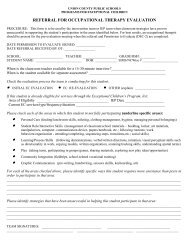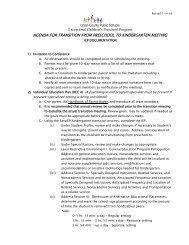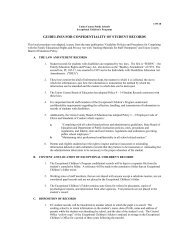Occupational Therapy and Physical Therapy Services in the School
Occupational Therapy and Physical Therapy Services in the School
Occupational Therapy and Physical Therapy Services in the School
Create successful ePaper yourself
Turn your PDF publications into a flip-book with our unique Google optimized e-Paper software.
<strong>Occupational</strong> <strong>Therapy</strong> <strong>and</strong> <strong>Physical</strong> <strong>Therapy</strong><br />
<strong>Services</strong> <strong>in</strong> <strong>the</strong> <strong>School</strong><br />
<strong>Occupational</strong> <strong>and</strong> <strong>Physical</strong> <strong>Therapy</strong> are related services available <strong>in</strong> <strong>the</strong> school sett<strong>in</strong>g if a<br />
child qualifies for special education services through <strong>the</strong> Exceptional Children’s Program.<br />
<strong>Occupational</strong> <strong>Therapy</strong> <strong>and</strong> <strong>Physical</strong> <strong>Therapy</strong> must be educationally relevant. Unlike <strong>and</strong> OT<br />
or PT <strong>in</strong> a cl<strong>in</strong>ical or medical sett<strong>in</strong>g who identify <strong>and</strong> treat <strong>the</strong> motor deficits, a school <strong>the</strong>rapist<br />
can only address those deficits that <strong>in</strong>hibit <strong>the</strong> child to benefit from his/her specially designed<br />
educational program or <strong>in</strong>dependence access<strong>in</strong>g <strong>the</strong> school environment. The need for <strong>the</strong>rapy<br />
services is not determ<strong>in</strong>ed by cl<strong>in</strong>ical diagnosis, low test scores, or o<strong>the</strong>r <strong>in</strong>dication of a gross or<br />
f<strong>in</strong>e motor deficit. Related services are selected because <strong>the</strong> team agrees that <strong>the</strong>y can best<br />
support <strong>the</strong> IEP team generated educational goals.<br />
If <strong>the</strong>re are not educational concerns that warrant special education services, <strong>the</strong>n OT or PT<br />
services are not <strong>in</strong>dicated. There are exceptions to this if a child has a genetic, neuromuscular,<br />
orthopedic or degenerative disorder. These children may not have cognitive impairments but<br />
have significant motor or visual impairments that affect <strong>the</strong>ir ability to access materials <strong>in</strong> <strong>the</strong><br />
school, or to be safe <strong>and</strong> <strong>in</strong>dependent <strong>in</strong> <strong>the</strong> school environment.<br />
With children who are identified as Speech/Language impaired only, OT or PT services are<br />
not <strong>in</strong>dicated, unless <strong>the</strong>y can support <strong>the</strong> Speech/Language goals. This may apply to a child with<br />
significant apraxia or significant sensory process<strong>in</strong>g difficulties.<br />
<strong>Occupational</strong> <strong>Therapy</strong> <strong>in</strong> <strong>the</strong> school sett<strong>in</strong>g looks at areas a child is not fully participat<strong>in</strong>g <strong>in</strong><br />
such as:<br />
· Personal Care (feed<strong>in</strong>g/lunchroom, toilet<strong>in</strong>g, cloth<strong>in</strong>g management, setup/cleanup)<br />
· Student Role/Interaction Skills ( manag<strong>in</strong>g classroom materials, general classroom skills,<br />
work behaviors/organization, social skills)<br />
· Learn<strong>in</strong>g/Process Skills (follow<strong>in</strong>g directions, attention, <strong>in</strong>itiation, visual perceptual<br />
skills)<br />
· Play (<strong>in</strong>dividual play skills, explor<strong>in</strong>g new play ideas/opportunities, shar<strong>in</strong>g materials,<br />
work<strong>in</strong>g <strong>in</strong> groups)<br />
· Community Integration/Work (fieldtrips, schoolrelated vocational tra<strong>in</strong><strong>in</strong>g)<br />
· Graphic Communication (h<strong>and</strong>writ<strong>in</strong>g, keyboard<strong>in</strong>g, draw<strong>in</strong>g, artwork)<br />
<strong>Occupational</strong> <strong>the</strong>rapists provide expertise <strong>in</strong> <strong>the</strong> areas of f<strong>in</strong>e motor/visualmotor skills, visual<br />
perceptual skills, ocular motor skills, sensory process<strong>in</strong>g/regulation, equipment<br />
adaptations/modification, assistive technology, vocational assessment, <strong>and</strong> selfhelp skills.<br />
Areas most often addressed by <strong>the</strong> <strong>Physical</strong> Therapist are:<br />
· Functional mobility/gait<br />
· Gross motor skills as <strong>the</strong>y relate to safety <strong>and</strong> a child’s ability to participate with peers<br />
· Postural control/seat<strong>in</strong>g<br />
· Balance<br />
· Equipment <strong>and</strong>/or environment adaptations/modifications<br />
· Transfer skills
2<br />
Assessment<br />
There are many ways on OT or PT can evaluate/assess a child to help identify deficits <strong>and</strong><br />
problems <strong>the</strong> child may be experienc<strong>in</strong>g <strong>in</strong> <strong>the</strong> school. These can <strong>in</strong>clude:<br />
· Concerns of <strong>the</strong> teachers, parents, <strong>and</strong> o<strong>the</strong>r school personnel<br />
· Observation of <strong>the</strong> child <strong>in</strong> <strong>the</strong> classroom, lunchroom, art, PE, playground, etc.<br />
· Assessment of class work<br />
· Functional school assessments which look at a wide range of task performance skills<br />
needed <strong>in</strong> <strong>the</strong> school environment<br />
· Cl<strong>in</strong>ical Observation/Assessments that look at underly<strong>in</strong>g performance components<br />
(muscle strength/tone, sensory, bilateral skills, gait, balance, postural control,<br />
shoulder/arm/h<strong>and</strong> control, etc.)<br />
· St<strong>and</strong>ardized test<strong>in</strong>g which can identify developmental level <strong>in</strong> relation to peers<br />
· Review of <strong>in</strong>formation/test<strong>in</strong>g by o<strong>the</strong>r discipl<strong>in</strong>es or outside <strong>the</strong>rapists<br />
Determ<strong>in</strong>ation for <strong>Services</strong> <strong>and</strong>/or Level of <strong>Services</strong><br />
This is based on many factors such as:<br />
· Child’s eligibility for special education services with educational concerns<br />
· Deficits significantly impact child’s ability to benefit from his special education goals<br />
· Amount of difficulty a child has access<strong>in</strong>g school environment <strong>and</strong> materials<br />
· The ability of o<strong>the</strong>r personnel to carry out goals or manage f<strong>in</strong>e motor/gross motor<br />
concerns<br />
· Overall progress rate over <strong>the</strong> term of <strong>the</strong> IEP<br />
· Whe<strong>the</strong>r cont<strong>in</strong>ued skill development can be best met <strong>in</strong> <strong>the</strong> least restrictive environment<br />
through <strong>the</strong> classroom, adaptive PE, regular PE, home program, etc.<br />
· Behavior issues, medical issues, or o<strong>the</strong>r factors that may make <strong>the</strong>rapy<br />
counterproductive<br />
· Previous attempts to improve <strong>the</strong> deficit have not been successful <strong>in</strong> o<strong>the</strong>r sett<strong>in</strong>gs, <strong>and</strong><br />
<strong>the</strong> unique expertise of a <strong>the</strong>rapist is required to meet student’s needs<br />
· If <strong>the</strong> student has critical health or safety needs that warrant a <strong>the</strong>rapist’s presence <strong>in</strong> <strong>the</strong><br />
educational environment<br />
· If <strong>the</strong> <strong>the</strong>rapist can provide/consult on adaptations <strong>and</strong> modifications <strong>in</strong> <strong>the</strong> environment<br />
IEP <strong>and</strong> Service Models<br />
After evaluation of <strong>the</strong> student <strong>and</strong> contribution of his strengths/weaknesses <strong>in</strong> regards to f<strong>in</strong>e<br />
<strong>and</strong> gross motor areas, OT’s <strong>and</strong> PT’s collaborate with <strong>the</strong> team on <strong>the</strong> best way to address <strong>the</strong>se<br />
areas. We strongly advocate look<strong>in</strong>g at <strong>the</strong> child as a whole versus a child with “OT/PT issues”,<br />
or “f<strong>in</strong>e motor/gross motor” problems. We are most effective when our services focus on<br />
<strong>in</strong>clusion (least restrictive environment), consultation, <strong>and</strong> serv<strong>in</strong>g <strong>the</strong> children through a<br />
collaborative IEP. If <strong>the</strong>rapy services are warranted, <strong>the</strong>y can be delivered <strong>in</strong> several ways:<br />
Direct: This can be done <strong>in</strong>dividually, <strong>in</strong> a small group, with<strong>in</strong> <strong>the</strong> classroom, or any<br />
comb<strong>in</strong>ation of this that would benefit <strong>the</strong> child most. This <strong>in</strong>volves <strong>the</strong>rapist contact with <strong>the</strong><br />
child as well as o<strong>the</strong>r related services such as consultation, adaptations/modifications, prepar<strong>in</strong>g<br />
materials, collaborat<strong>in</strong>g with o<strong>the</strong>r team members, develop<strong>in</strong>g programs for <strong>the</strong> classroom or<br />
home, etc. The extent <strong>and</strong> frequency of services can vary <strong>and</strong> is dependent on many factors.
3<br />
Related <strong>Services</strong> Support Plan (RSSP): This is used for students with m<strong>in</strong>imal <strong>the</strong>rapy needs,<br />
<strong>and</strong> is a means to provide necessary support to o<strong>the</strong>r personnel work<strong>in</strong>g with <strong>the</strong> student without<br />
<strong>the</strong> need for an IEP goal page. It outl<strong>in</strong>es what areas a <strong>the</strong>rapist will support <strong>in</strong> <strong>the</strong><br />
classroom/school environment, what classroom <strong>in</strong>terventions that are delegated to classroom staff<br />
with related service support, <strong>and</strong> is used most often with children who need ongo<strong>in</strong>g monitor<strong>in</strong>g<br />
for adaptations or programs, prevention of deteriorat<strong>in</strong>g conditions, or monitor<strong>in</strong>g of equipment.<br />
This can be needed on an ongo<strong>in</strong>g basis or short term.<br />
Regard<strong>in</strong>g <strong>Occupational</strong> <strong>Therapy</strong> services with a Sensory Process<strong>in</strong>g or Sensory Integrative<br />
Emphasis<br />
As with o<strong>the</strong>r OT services, <strong>in</strong>tervention with a sensory <strong>in</strong>tegrative emphasis can be provided<br />
only as it relates to <strong>the</strong> student’s school function <strong>and</strong> <strong>in</strong>terferes with a child reach<strong>in</strong>g his special<br />
education goals. A school OT can provide education regard<strong>in</strong>g sensory process<strong>in</strong>g <strong>and</strong> its impact<br />
on learn<strong>in</strong>g, strategies/modifications for <strong>the</strong> classroom/curriculum <strong>and</strong> school environment to<br />
help a child participate, <strong>and</strong> use of sensory modalities dur<strong>in</strong>g treatment or <strong>in</strong> <strong>the</strong> class to enhance<br />
attention, etc.<br />
Union County Public <strong>School</strong>s<br />
<strong>Occupational</strong>/<strong>Physical</strong> <strong>Therapy</strong> Departments<br />
7/09
















